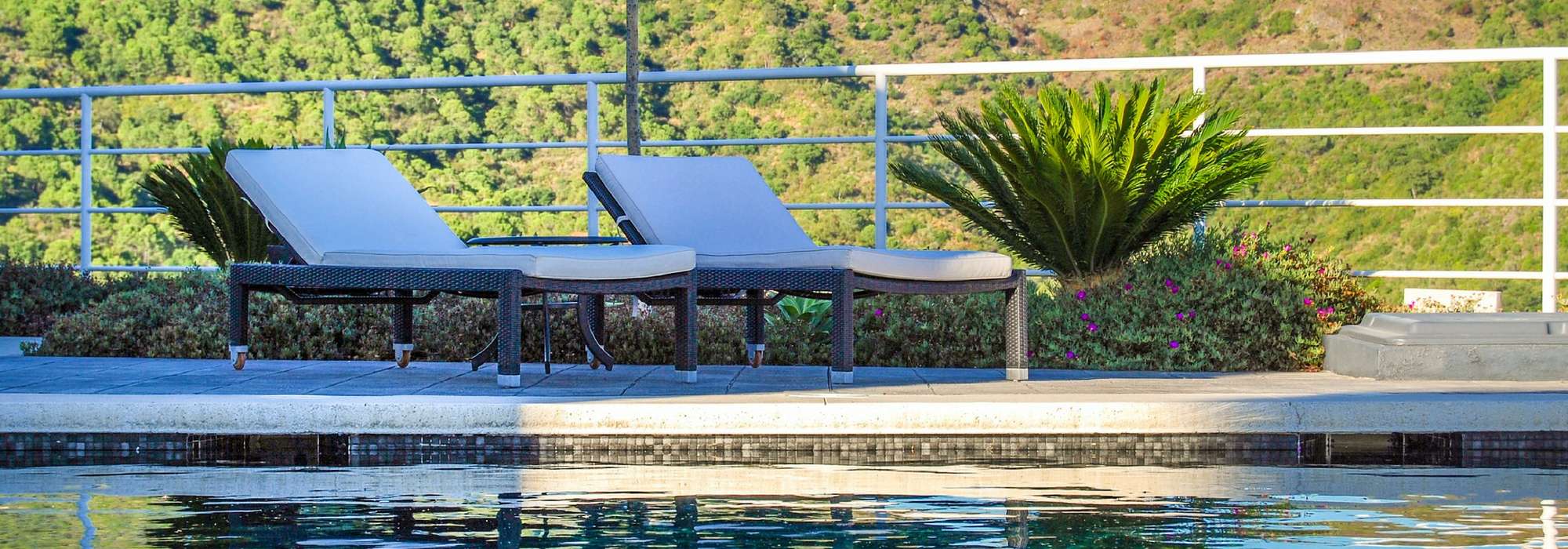
Designing poolside areas in 5 styles
Suitable plants and tips
Contents
Integrating a swimming pool into a garden is not necessarily easy. However, it is essential for it to harmonise, blend into the landscape, or provide privacy in case of overlooking. Whether you want to create a screen of greenery, an exotic or Mediterranean atmosphere, easy-to-maintain flower beds, or flowering containers: everything is possible. And when the pleasure of the eyes is added to the pleasure of swimming, it truly is paradise!
Discover our 5 atmospheres and the suitable plants to arrange the space around your swimming pool.
Mediterranean atmosphere
Situated in the sunniest spot, the swimming area often benefits from a microclimate that requires choosing plants that are low in water needs. The Mediterranean atmosphere naturally takes hold. Aromatic plants invite combinations of evergreen and decorative foliage, beautiful all year round and fragrant. The only maintenance they require is to prune everything back into cushions after flowering or at the end of winter.
Plant one or more olive trees or even Provence cypress. Aromatic plants are particularly well-suited to this environment: you can rely on thyme, sages, lavender, santolina, oregano, helichrysum, wormwood, or hyssop.
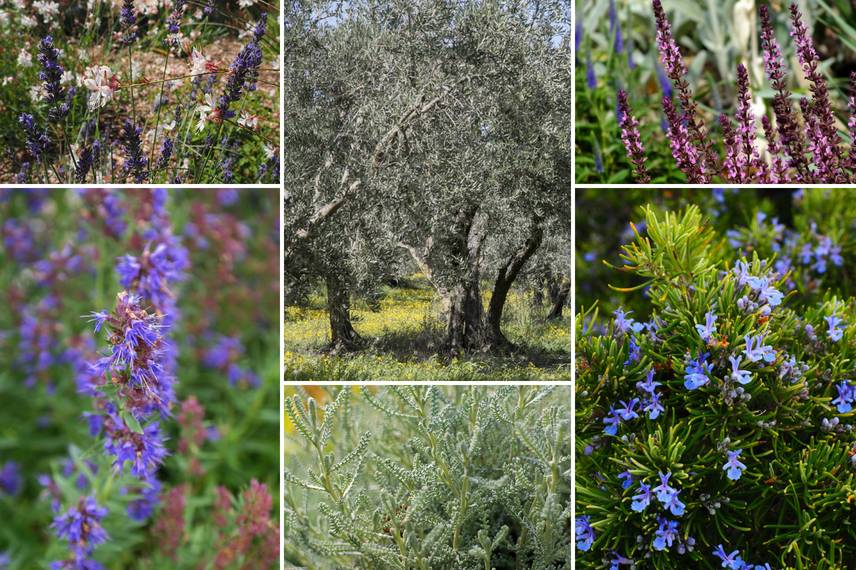
Some plants to adopt for creating a Mediterranean atmosphere: lavenders and gaura, Santolina chamaecyparissus, hyssop, sages, Stipa tenuifolia, rosemary, with olive trees in the background.
Some clumps of gaura, nepeta, perovskia, stipa, or calamagrostis will complete the picture. You can also add structure with balls of Pittosporum.
Consider mulching (plant material chippings, small pebbles) to prevent water shortage and limit weeding.
Exotic atmosphere
Do you have a desire for elsewhere? Transport yourself to a lush oasis amidst palm trees and bamboos or perhaps to a drier atmosphere.
-
An oasis of greenery
If your climate allows, why not add a touch of exoticism to your swimming area? To achieve this, simply plant some plants with a foreign appearance. Be aware that some species are hardy!
The undisputed star of this particular atmosphere is, of course, the palm tree. You will need to choose the species suited to your region’s climate or possibly protect it in winter: Washingtonia filifera, Phoenix canariensis… You can welcome a hemp palm almost anywhere (Trachycarpus fortunei), the most resistant (down to -18°C) or a windmill palm (Trachycarpus excelsa).
Bamboos are also essential in exotic gardens. However, opt for non-running species such as Fargesia rufa or Fargesia murielae.
A banana plant is also possible; choose the most cold-resistant: Musa Basjoo. It does, however, require good protection from winter cold.
Cordyline adapts very well to our regions (but does not tolerate temperatures below -8°C), where it grows very quickly and easily. Also consider Cycas or Yucca filamentosa for harsher climates.
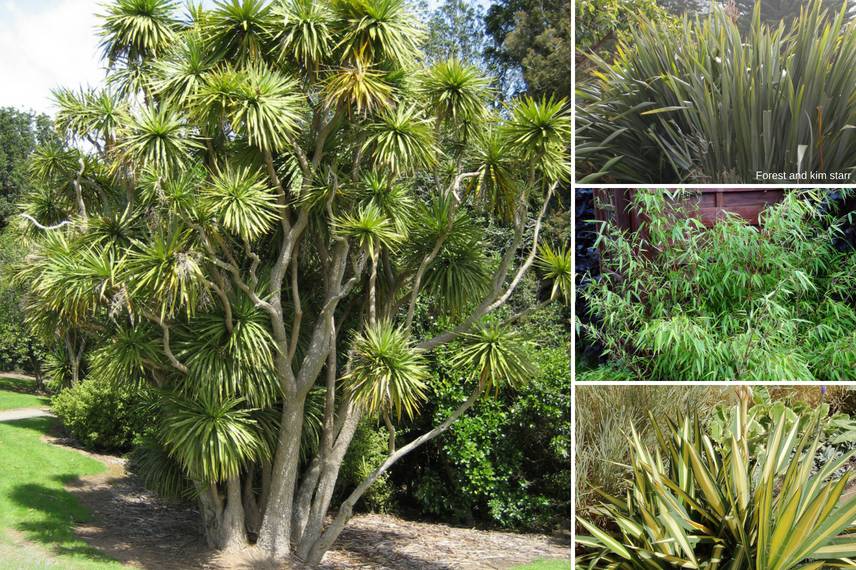
Some plants to integrate for an exotic atmosphere: Cordyline australis, Phormium tenax, Fargesia rufa or Yucca filamentosa ‘Color Guard’.
Finally, do not hesitate to use opulent and highly decorative plants such as Phormium tenax, commonly known as New Zealand flax.
-
Dry garden atmosphere
It is also possible to imagine a somewhat Mexican landscape with dwarf palms, Euphorbia myrsinites, and perennials that thrive in the driest conditions: golden basket, cerastium, armeria, arabis, sedum, delosperma, etc.
However, be cautious with agaves, aloes, and cacti, which can be dangerous near the pool, especially with children around.
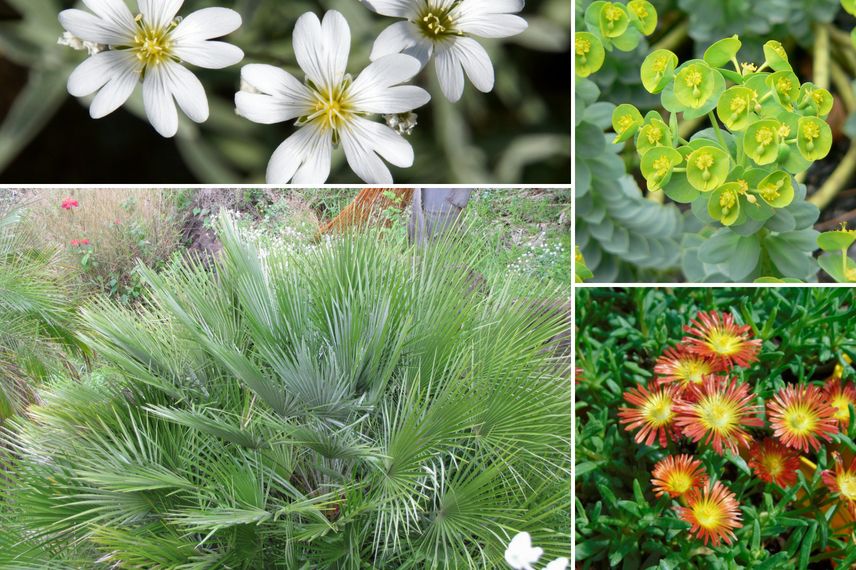
Some exotic-looking plants: Cerastium tomentosum, Euphorbia myrsinites, Chamaerops humilis ‘Compacta’, Delosperma ‘Wheels of Wonder Fire’.
Contemporary atmosphere
If you love contemporary atmospheres, opt for plants with a graphic appearance such as equisetums that create beautiful vertical arrangements, topiaries that enliven the space all year round, and grasses that bring movement.
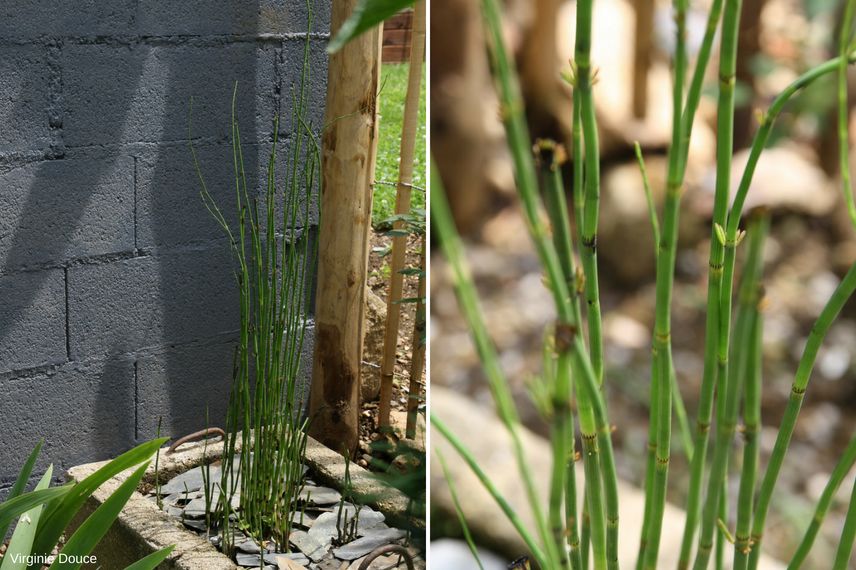
Horsetail (Equisetum hyemale) is a very graphic plant, ideal for a contemporary setting.
For flowering, prefer plants with self-cleaning flowers to make maintenance easier, such as agapanthuses or dahlias.
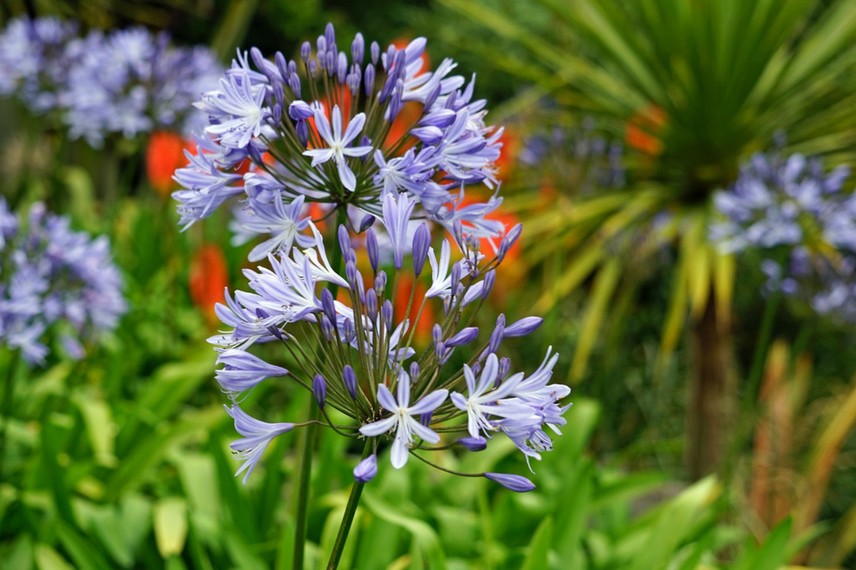 [caption id="attachment_43229" align="aligncenter" width="856"]
[caption id="attachment_43229" align="aligncenter" width="856"]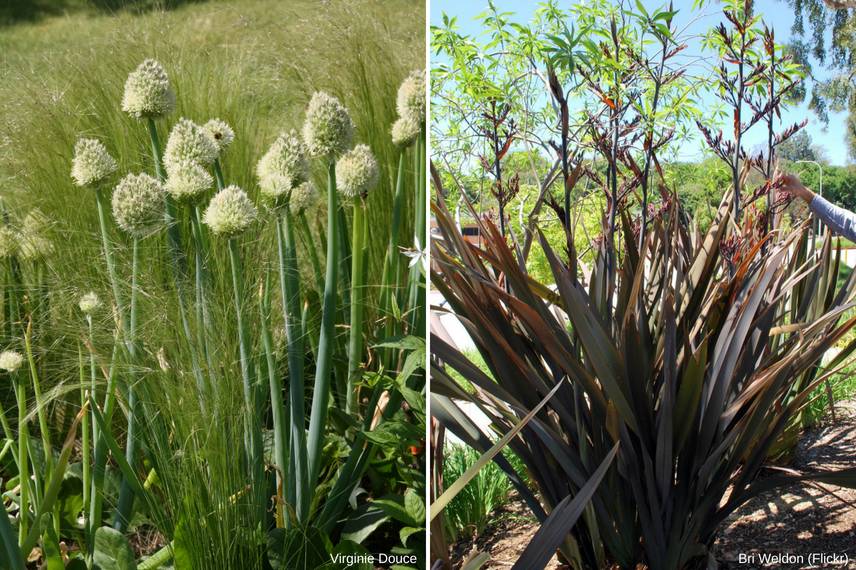 Alliums and Stipa tenuifolia – Phormium tenax.
Alliums and Stipa tenuifolia – Phormium tenax.Phormiums adapt well to various settings. They are particularly suited to poolside areas, and their decorative foliage is a real bonus.
Finally, do not overload; contemporary atmospheres are rather minimalist. A few well-chosen graphic plants set the tone.
Read also
Planting olive treesCountry atmosphere, a safe bet in all climates
If you prefer to rely on tried-and-true options for all climates, opt for the classic yet effective free-standing hedge and easy-to-maintain perennials.
-
Classic and effective: the free-standing hedge
To shield yourself from prying eyes, the free-standing and flowering hedge is a reliable choice that is easy to maintain. The bushes, planted wisely, will also help protect you from prevailing winds. Whenever possible, prefer evergreen bushes.
In temperate zones, choose from viburnums, weigelas, hibiscus, the Bohemian olive (Eleagnus ebbingei), photinia, Mexican orange, abelia…
In mild climates, turn to oleanders, bougainvilleas, lagerstroemias, callistemons, or escallonias…
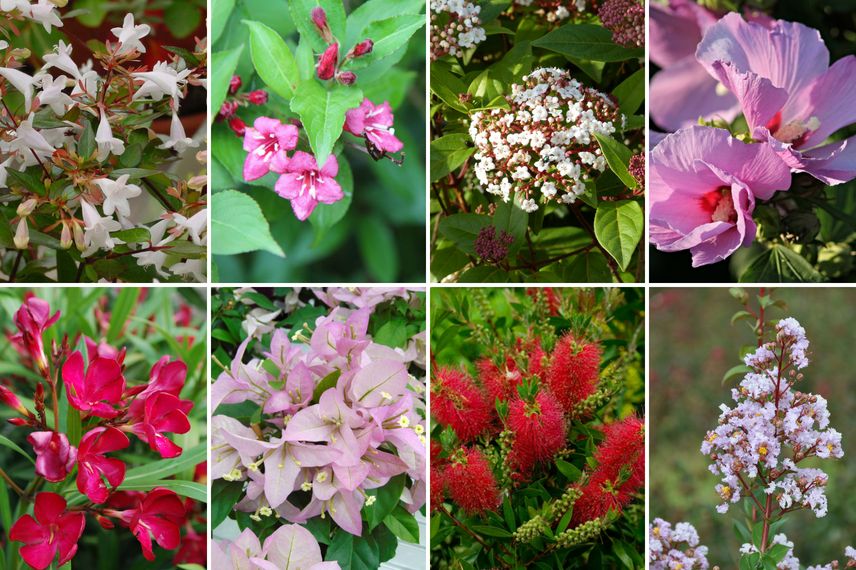
Examples of free-standing hedges: Abelia grandiflora, Weigelia ‘Bristol Ruby’, Hibiscus syriacus ‘Lavender Chiffon’, Viburnum tinus ‘Spirit’ (top row) and in mild climates, Nerium oleander, Bougainvillea ‘Rijnstar Lila’, Callistemon laevis, Lagerstroemia ‘Camaieu d’été’ (bottom row).
If space is a bit limited, you can also install privacy screens such as wooden trellises or latticework that allow you to train climbing plants, while also providing protection from prying eyes.
-
Focus on perennials
Natural-looking perennials require very little maintenance and are perfect for enhancing poolside areas.
Grasses are trendy plants, light and easy to care for, requiring only the cutting back of the clump (close to the ground) at the end of winter, or even nothing at all (except perhaps a little tidying up) for evergreen species. They are very easy to grow and enliven the garden for a good part of the year. Miscanthus, fescues, pennisetum, carex, stipa… the choices are vast!
You can add some splashes of colour with Buenos Aires verbena (Verbena bonariensis), columbines, alliums, knautia, agapanthus, etc.
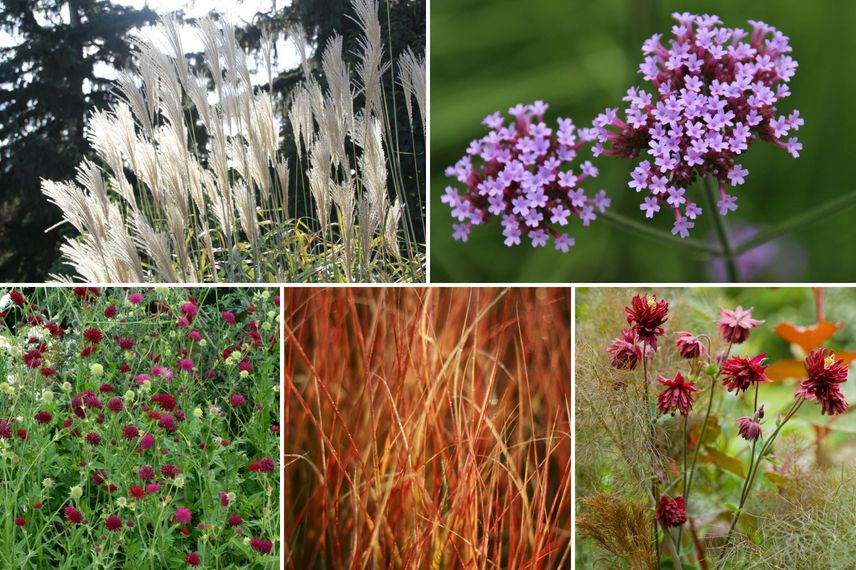
Some plants for a natural atmosphere: Miscanthus, Verbena bonariensis, Knautia macedonia, Stipa arundinacea (Anemanthele lessoniana), Aquilegia vulgaris ‘Ruby Port’.
Some tips
- We recommend leaving 1.5 to 2 m between the edge of the water and the flower beds. Similarly, leave at least 7 m between the water and a hedge to avoid being bothered by fallen leaves or wilted flowers that can pollute the water with the slightest breeze, buzzing insects too close, or the shade that can hinder the warming of the water and sunbathing. Conversely, water is often treated with chemicals like chlorine. These products are harmful to vegetation.
- If you are allergic to bees and do not want them to come too close to the pool area, avoid highly melliferous, fragrant plants or choose a cultivar with double flowers, which are significantly less visited by insects. Alternatively, select plants that bloom outside the summer period. Otherwise, opt for grasses that are not pollinated by bees.
- Avoid thorny plants such as pyracantha, pointed-leaved yuccas, or very thorny roses. For the latter, prefer less thorny varieties like ‘Iceberg’, ‘Blush Noisette’, ‘Mortimer Sackler’, or ‘Zephirine Drouhin’ and ‘Veilchenblau’ that can be trained on a trellis, for example.
- Also avoid trees and bushes that produce many suckers, such as Japanese quince, sorbaria, and lilac.
- Do not plant fruit trees whose fruits attract wasps, and fallen fruits stain the soil.
- Finally, be aware that flowers in shades of pink, purple, or white pair wonderfully with the azure blue of pools.
- Subscribe!
- Contents
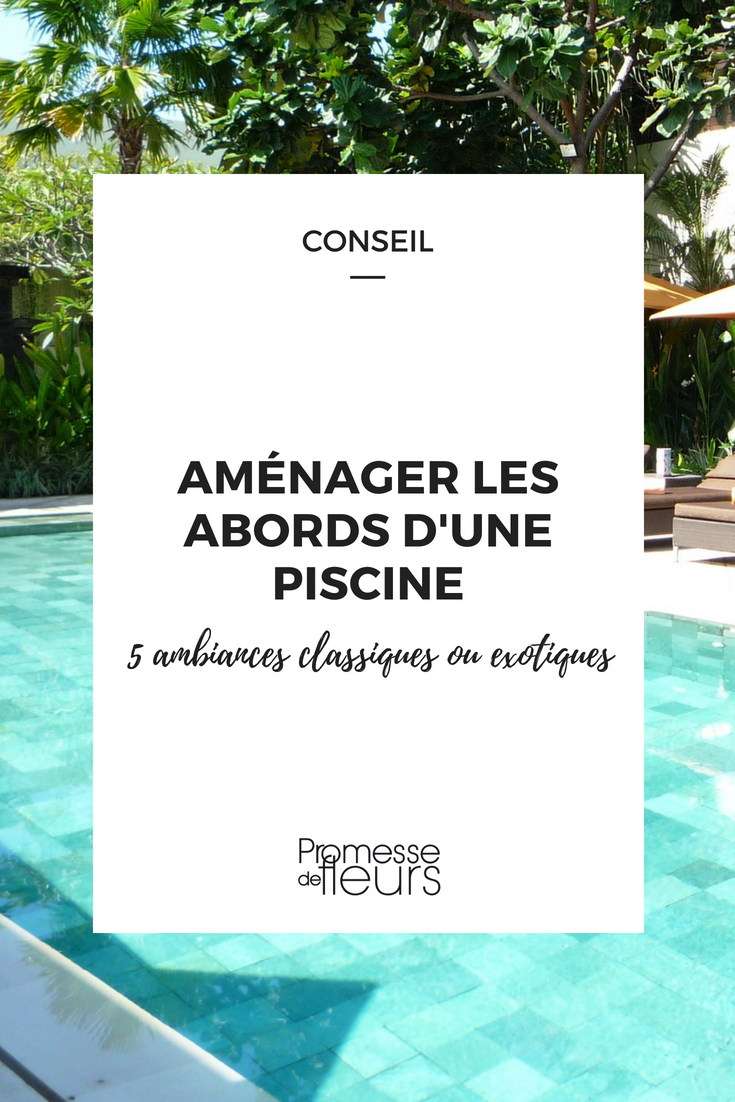































Comments